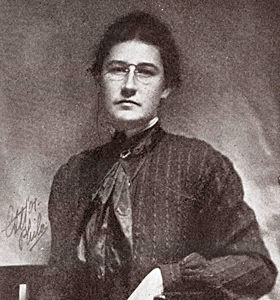Jessie Willcox Smith ![]()
Always fond of children, Jessie Willcox Smith began her career as a kindergarten teacher in Cincinnati, Ohio. She soon found that her height, combined with frequently bending over to assist children, was causing her physical pain. An opportunity to change careers soon presented itself while accompanying a friend who was giving an art lesson. The art teacher asked the student to draw a lamp and suggested that Jessie sketch it also. Never having drawn objects before, she used a pencil to quickly outline the lamp. When her friend took a look at her drawing, she was so impressed that she showed it to her mother, a noted illustrator. This recognition of her natural talent and ability for art led Jessie to abandon her teaching ambitions and become an artist.
She began her illustrious career with sculpture, but found the materials a bit costly stating, “Heavens, being a sculptor is too expensive! I’ll be a painter!” [1] She returned to her hometown of Philadelphia in 1885 to enroll in the School of Design for Women but quickly transferred to the Pennsylvania Academy of the Fine Arts where she was taught by the great American artist, Thomas Eakins.
In 1888, her illustrations began to appear in magazines, first in the St. Nicholas magazine for children and then in the Ladies Home Journal as well where she illustrated advertisements and provided borders for editorials.
Six years later, she began taking art classes at Drexel Institute where the noted illustrator, Howard Pyle, mentored her. He changed the way she viewed illustrations, encouraging her to imagine the characters and actually live the story instead of considering the composition of a picture as an abstract object.
Smith became close friends with two other students of Pyle’s, Violet Oakley and Elizabeth Shippen Green, sharing a studio apartment, creativity, ideas, and their art with each other. After moving together to the Red Rose Inn near Bryn Mawr in order to have more space to paint, they were joined by another close friend, Henrietta Cozens, who managed their household, although she was not an artist herself. The four of them were collectively known as the Red Rose Girls. Some years later, the four moved together to a home on Chestnut Hill they called, “Cogslea”—the first four letters being the initials of their last names.
Jessie Willcox Smith's artistic style was known as Romantic Realism. She greatly enjoyed painting scenes with children and felt that was her strength. Although best known for her iconic illustrations of childhood classics such as Robert Louis Stevenson’s A Child’s Garden of Verses, Charles Kingsley's The Water Babies, and George MacDonald's At the Back of the North Wind, she benefited financially from her advertisements for Ivory Soap, Campbell Soup, Kodak, and Fleischmann’s Yeast among others. While Smith never married and had no children of her own, she generously used much of her significant income to support her relative’s children as they had need, at one point financially supporting 11 children.
She did not care for professional child models, instead preferring her friends’ children whom she could observe playing naturally in the flower gardens around her home. She would sometimes tell fairy stories to the children she was painting in order to hold their attention but found it difficult to do both. She said,
“A child will always look directly at anyone who is telling a story; so while I paint, I tell tales marvelous to hear. But to paint with half one’s mind, and tell a thrilling, eye-opening tale with the other half is an art I have not fully conquered even yet. And sometimes the resplendent Cinderella sometimes stops halfway down the stairs, slipper and all, while I am considering the subtle curve in the outline of the listener’s charming, enthralled little face." [2]
Ms. Smith felt that outdoors was the most natural environment for painting children:
“I want children under the blue sky, in the shining radiance and joy which is their birthright, and with the flowers of God’s earth, of which they are only a higher bloom at their feet.” [3]
Upon exploring the large number of classic children’s books Ms. Smith illustrated, it becomes obvious that she perfected her skill in depicting beautiful scenes of childhood. Her love for children stayed with her throughout her years as an illustrator. This quote exemplifies her appreciation for them:
“It has been one long joyous road along which troop delightful children, happy children, sad children, thoughtful children, and above all wondering, imaginative children, who give to their charmingly original thoughts a delicious quaintness of expression. I love to paint them all.” [4]
—Biblioguides Team
[1] An interview with Jessie Willcox Smith taken from a Personal Collection from The Archives of the Pennsylvania Acaemy of the Fine Arts.
[2], [3], [4] S. Michael Schnessel, Jessie Willcox Smith, Crowell, 1977













